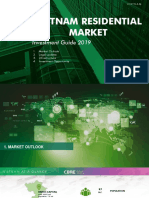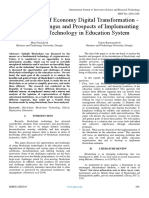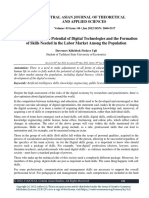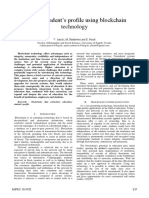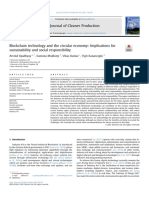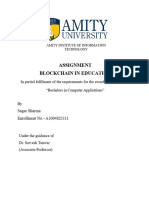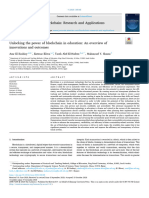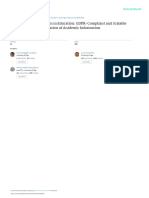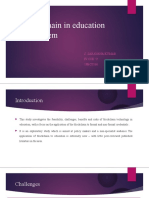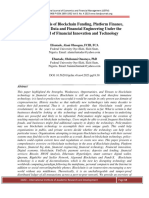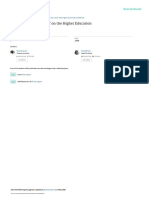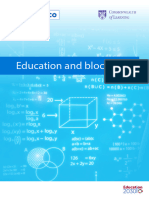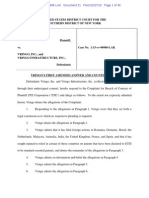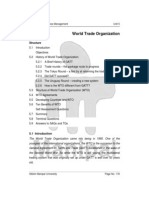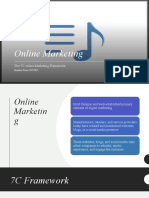Professional Documents
Culture Documents
Blockchain Revolution Enhancing Moroccan Higher Education For The Digital Age
Original Title
Copyright
Available Formats
Share this document
Did you find this document useful?
Is this content inappropriate?
Report this DocumentCopyright:
Available Formats
Blockchain Revolution Enhancing Moroccan Higher Education For The Digital Age
Copyright:
Available Formats
Volume 8, Issue 5, May – 2023 International Journal of Innovative Science and Research Technology
ISSN No:-2456-2165
Blockchain Revolution: Enhancing Moroccan Higher
Education for the Digital Age
TAMER Hind, (PhD in Management Science) KNIDIRI Zakaria, (PhD in Management Science, Professor)
Faculty of Law, Economic and Social Sciences, Marrakech Faculty of Law, Economic and Social Sciences, Marrakech
Cadi Ayyad University of Marrakech, Morocco Cadi Ayyad University of Marrakech, Morocco
Abstract:- Analyzing the potential of integrating students to acquire skills that they must organize into a
blockchain technology in higher education is a portfolio as they enter the world of work and the profession.
multifaceted undertaking due to the complex and
contradictory nature of the higher education Bartolome, Lindín & Steffens (2022) argues that this line
environment. in which conflicting visions of its mission, of work is only timidly hinted at. But it seems a quite likely
organization and governance coexist. The excessive consequence in the medium and long term, which will involve
expectations created around blockchain result in a radical change in the way education, institutionalized and
exaggerated promises and a certain widespread systematized since the nineteenth century, is viewed, which
technological determinism. blockchain have created could be transformed in the next century into something very
excessive expectations. This article aims to provide a different from what we know today as the education system.
balanced perspective by tempering enthusiasm and The blockchain would provide evidence of the acquisition of
facilitating a deeper understanding of the underlying knowledge gained in various environments. Zhang, & al.,
assumptions and vision of blockchain in proposals to (2022) suggest that the use of blockchain, and smart contracts
revolutionize higher education and establish new will have significant value on centralizing learning around the
educational ecosystems through digital technology, student, so that the system would adapt to each student, rather
specifically blockchain. Blockchain has been hailed by than each student having to adapt to the system, as is the case
some management and economic sectors with a vested today.
interest in the new higher education as an emerging
innovation, with innumerable benefits. However, these visionary articles have not been translated
into real solutions that can be implemented to date, and we
Keywords:- Blockchain; Meta University; Moroccan; Higher can only observe approaches to this type of development.
Education. Blockchain, understood as a disruptive technology associated
with crypto-currencies, particularly bitcoin, as its knowledge
I. INTRODUCTION develops, its use becomes more widespread and its
application extends beyond digital currencies, so this research
The evolution of the digital society of knowledge and essay presents a literature review of the object of study in the
information is highlighted by the imminent advance of academic sphere (Zhang, & al., 2022).
technology that impacts many areas, including education, this
has enriched the development of the educational fact and In the field of higher education, it offers possibilities for
transform and adapt the models in higher education the development and improvement of the management of the
institutions, in addition to improving the capabilities of the higher education system, in terms of control and monitoring
organization, as universities must be at the forefront of these of the development of the teaching and student learning
technological and educational innovations, based on what has process, and in the field of research, a contribution to the
been raised (Hernandez, & al., 2022). Anthony (2022), argues resolution of an important problem in publications, avoiding
that the current model of higher education is increasingly plagiarism, since everyone would have access to the
decentralized, heterogeneous, difficult to verify and validate, information and the authorship and references would be
which leads to various open problems for each representative known (Zhang, & al., 2022). The progress of this technology
of the business model that involves the training of in the field of higher education is not as accelerated, due to
professionals for incorporation into the world of work, that is, the short time of its creation, 2009, but it has started to make
trainers (regulated or not), students and employers. In inroads in this field with different innovations in some
addition, the authors state that it is increasingly common for processes that were taking place in a traditional way, such as
students to receive training not only in regulated universities, certifications, qualifications, student identity, personalized
but also by participating in massive open online courses educational paths, payment of fees, intellectual property,
(MOOCs), face-to-face or remote workshops, video tutorials, among others. It is the renewal of these processes, based on
conferences, or video interviews, among others, in different the immutability of records in the blockchain and the
institutions. All of these sources of knowledge, as well as possibility of guaranteeing the validity of all documents
professional practice itself, represent a spectrum that leads (Bartolome, Lindín & Steffens, 2022).
IJISRT23MAY1084 www.ijisrt.com 833
Volume 8, Issue 5, May – 2023 International Journal of Innovative Science and Research Technology
ISSN No:-2456-2165
Given this scenario and the possibility of promoting compilation of written documents, as well as to take access
innovative mechanisms in the academic sector, this research tests and interviews of all kinds in order to be able to
aims to present an approach to the state of the art of the guarantee the skills and competences he/she has acquired.
applicability of Blockchain in Higher Education, describing From the point of view of universities, there is growing
the fundamentals and developments of this technology in this criticism from the employability field that university
sector to know and reflect on the respective impact, in education is often unable to adapt quickly and flexibly to the
addition to the contribution to educational management in this training needs of the labor market with an adequate time-to-
digital society of knowledge and information (Bartolome, market.
Lindín & Steffens, 2022).
B. Blockchain Technology Basics
Most people are not familiar with the term blockchain, not Blockchain is a technology that allows to keep records of
to mention the possible applications of using blockchain information in a distributed, decentralized, synchronized and
technology. Although researchers discussed the use of very secure way, respecting identity and privacy (Miraz, &
blockchain in the commercial area (Swan, 2017) several al., 2020). These records do not allow alteration, undoing or
studies focused on how blockchain technology can be applied rewriting of what has been stored. Any institution can obtain
in education (Turkanović, & al., 2018; Chen, & al.,), This many benefits if it correctly applies the Blockchain, which
paper will discuss the critical terminologies of blockchain also prevents falsifying or deleting the recorded information,
technology through a literature review, such as "distributed this being a fundamental characteristic, the immutability of
ledger", "blockchain" and "the verification mechanism". Also, the chain (Shin, 2019).
the current applications of blockchain technology in education
are reviewed. Then, the innovative applications of using Loignon (2017) defines Blockchain as a digital record of
blockchain technology in education and the advantages are transactions, distributed throughout the network and whose
presented with recommendation to use it in Moroccan higher copies are identical on each member's computer, where no
education. central authority governs therein. Any actor in the network
can view log entries and record new transactions,
II. LITERATURE REVIEW disagreements are resolved by consensus of the majority of
members. Miraz, al., (2020) argues that these transactions are
Digitalization is a tool for the innovative development of grouped into blocks which are then linked together, forming a
higher education, changing the demand for professions and blockchain, hence the name Blockchain. The data in the
the competencies of university graduates. Digitalization of blocks is encrypted and cannot be decrypted in theory, so
higher education is a global trend that will only increase once stored, the information can no longer be erased. In
following the growth of the educational services market in essence, the Blockchain contains an accurate, time-stamped
general and online education in particular. and verifiable record of every transaction.
A. The current model of higher education digitalization In the same sense, Allende, & al.,(2023) argues that
The current model of higher education is becoming Blockchain, is due to the structure of this record, consisting of
increasingly decentralized, heterogeneous and difficult to sets of transactions that are organized and stored in blocks.
verify and validate, resulting in a number of open problems Which are ordered chronologically and have an identifying
for each representative of the business model involved in number, an alphanumeric code known as hash and digitally
training professionals for incorporation into the world of signed by the person who proposes or validates the block.
work, students and employers. It is increasingly common for Regarding the use of this technology in the education sector
students not only to receive training from regulated (Bhaskar, & al., 2022).
universities, but also to be trained through participation
(through studies directed from these universities or as a result Thus, predictions suggest that it will directly affect the
of proactive independent study) in massive open online management of many internal processes, allowing in a simple
courses (massive open online course [MOOC]), in face-to- way an automated management of grades and exams, in
face or distance workshops, in video tutorials, in talks or addition to avoiding any type of fraud such as plagiarism or
video interviews, etc. (Bartolomé, Bellver, Castañeda and change of grades. A very important aspect in Blockchain
Adell, 2017). corresponds to Smart Contracts, Allende, al., (2023) argues
that they allow establishing and defining how and who can
All these sources of knowledge, as well as the carry out transactions. These are contracts in which a series of
professional praxis itself, represent an endless range that clauses are defined and specified, such as the controls to be
originates in the student the acquisition of competences that met by the merchandise mentioned in the previous section and
must be put into play at the time of their incorporation into the the final payment agreed in case these are exceeded. These
professional world. However, it is very difficult to quantify, are incorporated into the blockchain in the network, which
value and validate such knowledge when it does not come guarantees their security and provides the appropriate
from regulated studies dependent on a centralized environment for their automatic processing (Bhaskar, & al.,
administration (Caño, 2016). And even coming from 2022).
regulated studies, the design of each curriculum is so varied
that the student is forced to make a very extensive
IJISRT23MAY1084 www.ijisrt.com 834
Volume 8, Issue 5, May – 2023 International Journal of Innovative Science and Research Technology
ISSN No:-2456-2165
In the educational field, Bartolomé, Bellver, Castañeda Bartolomé, & al., (2017) state that the starting point for
and Adell (2017) argues that, the basic model of curriculum the use of Blockchain in education is accreditation. of the
design responds to a fragmentation of the program into small curriculum vitae, in addition to other applications to
blocks (read activities, units, lessons...) that the student goes portfolios, evidence of learning, badges in gamified
through according to his own needs and aptitudes. Each unit applications, among others. These authors point out that it
translates into an intelligent contract that will be resolved may take years for a relevant implementation in the
when the subject has acquired the knowledge or skills educational area. However, these authors mention that
satisfactorily. Based on the above, smart contracts can be used changes are occurring rapidly and possibly the speed of this
in universities for the development of student control and implementation will be more conditioned by the rapid social
monitoring processes, based on a set of clauses that can adoption of technology than by the success of these
address all academic and administrative issues related to experiences. Around possible and probable real applications
student identity, learning path, accreditation, certification, of Blockchain in education, Grech and Camilleri (2017)
grades, payments, intellectual property, among others. argues that the accelerate the end of "paper-based
Blockchain works as a distributed database, in which the pairs certification" systems, "automate credit recognition and
are cryptographically secure, because it can only be updated transfer", store and verify the complete record of formal and
through consensus among the nodes, all participants that are informal learning achievements throughout a person's life,
in the distributed network. The mechanism through which the who will be able to automatically verify the validity of
transactions performed by the nodes are validated is by means certificates awarded to him or her without contacting the
of a consensus algorithm, which focuses on executing organization that issued them, track the uses of materials
cryptographic operations. under intellectual property, reduce the costs of data
management for educational organizations, streamline
C. Blockchain Technology and Higher Education payments to some institutions with ad hoc cryptocurrency,
After the text edit has been completed, the paper is ready school checks or scholarships. In this same sense, Roebuck
for the template. Duplicate the template file by using the Save (2019) argues that it is too early to talk about Blockchain in
The technological evolution in the information and education, however, he highlights that there is research, which
knowledge society, merits the incorporation of technology in is presented in this article, promising advances and
educational processes to promote its transformation and innovations in the area, likewise the mentioned author shares
educational innovation. According to the experts, Bartolomé, five ways in which this technology is revolutionizing higher
Bellver, Castañeda and Adell (2017) education is one of the education.
next scenarios where Blockchain technology, can offer a
transformation and change in educational centers, especially Pelletier (2018) agrees that researchers will be more
in universities, where it could be applied both inside and willing to share their scientific accomplishments while
outside the classroom, in the construction and management of maintaining control over them through blockchain.
personalized learning paths. Blockchain technology is Ultimately, this will lead to greater trust and interdisciplinary
commonly used for the issuance and verification of collaboration. Layne (2019) emphasizes that blockchain
educational certificates such as diplomas, transcripts, student technology will simplify the university admissions office. The
competencies, achievements and professional skills that can list of services provided by admissions offices and dean's
be checked by employers worldwide (Alammary et al., 2019). offices is broad, covering both initial work with applicants
The impact that Blockchain has had on higher education can and organizational support for students, including academic
be evidenced, around the development of applications to meet travel. Depending on the size and structure of the university,
specific needs, in addition to the different opportunities it the list may include both traditional tasks and specific
offers to students, professors and institutions to optimize the responsibilities (credit accounting in connection with the
academic and organizational processes that are developed, transfer of students from another institution, language and
corresponding to the management of certifications, digital cultural support, time management training, financial
identity of students, educational uses, intellectual property, assistance, etc.). Blockchain even at the stage of admission
payment processes, among others (Rajnak, & Puschmann, the university will be able to suppress fraud related to
2020). falsification of grades, legitimacy of sports and other
achievements, grounds for benefits, distortion of personal
Blockchain technology makes the certification process data, etc. According to Haque, & al., (2023), blockchain will
faster by allowing employers to save time spent verifying contribute to the popularization and legitimization of online
academic results. It offers benefits to the education sector by learning, which will significantly reduce unemployment
providing a secure platform to share student data, reduce around the world, it will give the chance to get an online
costs, ensure visibility and build trust (Rajnak, & Puschmann, education to those people who have no opportunity to get
2020).. Blockchain technology maintains a complete record of offline, and further help with job placement, as all diplomas
courses in time-stamped data blocks in sequential order. Old and certificates contained in blockchain are official and
and new blocks of data cannot be removed and the reliable, as blockchain allows standardization of certificates
cryptographic algorithm prevents data corruption (Wang, and diplomas obtained through online learning, which means
2022). that the technology will allow in future to legitimize online
learning
IJISRT23MAY1084 www.ijisrt.com 835
Volume 8, Issue 5, May – 2023 International Journal of Innovative Science and Research Technology
ISSN No:-2456-2165
Regarding the type of use of this technology, some learning ledger records detailed information about the
authors propose categorizations based on certain applicability learning experience of learning experience and tracks the
criteria. Swan (2015) proposes the following: development of their knowledge and skills. knowledge and
Blockchain 1.0 refers to applications related to crypto- skills(Pina, A.Torlà, Quintero, et Segura, 2017). All of these
currencies, such as transactions, payment systems and can be transformed into a kind of digital currency and stored
fund transfers. in a blockchain network according to a comprehensive set of
Blockchain 2.0 is oriented towards smart contract standards. Students will be rewarded for their rewards through
applications for economic and financial activities, such as their study efforts, which is called “learning is earning” (Pina,
financial transactions, mortgages, real estate, etc. A.Torlà, Quintero, & Segura, 2017).Some schools have also
Blockchain 3.0 includes applications for areas such as started implementation with this concept, for instance, (Pina,
public administration, health, science, among others. A.Torlà, Quintero, & Segura, 2017).claimed a kind of
According to Swan (2015), there are three types of educational reputation currency educational reputation called
blockchain based on access and visibility of transactions: Kudos, like Likes on a facebook post. a facebook post. It can
Public blockchains, which anyone can access and whose be used to measure learning outcomes and is stored in a
transactions are public (for example, Bitcoin and virtual wallet.
Ethereum).
Private blockchains, where access is by invitation (e.g. E. The Meta-University
Hyperledger, R3 and Ripple). - According to Kosasi (2022) blockchain will enable the
Hybrid blockchains, which combine the above elements, University of the 21st century to become a network and an
ecosystem. In this sense, innovators have a great opportunity
where nodes join by invitation but transactions are public.
to create a relevant educational experience, for students
The momentum of this technology is due in large part to anywhere, assembling the world's best online learning
materials, and allowing students, from wherever they are
the fact that some platforms are available under the open-
source regime, as well as the commitment of governments, geographically located, to organize their learning journeys
with the support of a network of tutors and facilitators who
multilateral organizations, and large corporations to promote
are specialists in the different areas of knowledge. According
its adoption.
to Kosasi (2022), to develop these schemes for students,
D. Implementation of blockchain universities will require profound structural changes, and
educators will need to work collaboratively.
Although blockchain technology is in the top 10 of
Gartner's trends (2018), it is essential to understand it and
Some Blockchain experts see great potential in its
clearly identify the benefits of its application, taking into
application in the educational area, Grech and Camilleri
account its capabilities, limitations and the technical
(2017) note that the research addresses the value that
capabilities required for its implementation. According to
Blockchain can bring in the education sector, through an
Gartner (2018) these technologies are still immature,
insufficiently tested and largely unregulated. As far as approach that explores its potential for digital accreditation of
personal and academic learning. Grech and Camilleri, (2017)
implementation is concerned, the consultancy notes that CIOs
are not developing plans for the application of this explain how this disruptive technology can transform
technology. This situation is attributed to the complexity of its institutional norms in a favorable way and empower students
approach, the lack of specialised profiles for its application, in its use in a responsible, secure, fast and transparent way,
among others.
Carneiro and al., (2018), raise some possibilities of the use
On the other hand, some companies are identifying how to of Blockchain, due to the fact that it is a network that allows
use the technology, although the lack of proven use cases to execute processing and perform storage in a shared way.
The mentioned authors highlight that its use can be observed
raises concerns about its viability. However, this situation
could change quickly considering that more and more cloud in some aspects of these institutions, corresponding to:
-Exchange and validation of circulating information in
services are integrating blockchain as a service into their
universities;
service portfolio, including recently Amazon Web Services
(Gartner & Panetta, 2017). -The creation of online digital identities to perform the
services offered by the university;
In addition, blockchain technology helps to reduce grade -Debureaucratization of administrative procedures with
fraud. In the past, there have been numerous cases of grade reduction of operational effort; (d) Security mechanisms
fraud. However, it can be avoided by using blockchain to and university data and information;
award and manage the student degree now. Miners around the -Collaboration in the development and monitoring of the
world verify, validate and maintain data that matches users' Institutional Development Plan (PDI);
identification and stored in the blockchain, blockchain's -Access to citizen information, especially with regard to
distributed ledger is immutable and reliable (Haque, & al., the implementation of the Open Data Plan of the
2023), immutable and reliable. Therefore, trustworthiness Institution.
and authority are assured, which will significantly reduce
grade fraud. In addition, blockchain can be used as a bank of Currently some universities and colleges have applied
capacity-currency transformation specifically, the blockchain blockchain technology in education, and most of them use it
IJISRT23MAY1084 www.ijisrt.com 836
Volume 8, Issue 5, May – 2023 International Journal of Innovative Science and Research Technology
ISSN No:-2456-2165
to support the management of academic degrees and the power and fairness than the traditional contract. Therefore, if
summative assessment of learning outcomes (Pina, Torlà, professors and students conduct instruction and learning
Quintero, & Segura, 2017; Batubara, Ubacht, & Janssen, activities based on smart contract, some of the educational
2018; De Freitas 2018). Blockchain technology can formulate problems would be solved.
the entire transcript. In the formal learning context, this
includes learning content and learning outcomes, as well as From the students' point of view, some subjective or
students' academic achievements and certificates. objective negative factors, such as lack of motivation and
Subsequently, in the informal learning context, this includes financial pressure, still cause poor learning outcomes.
information about research experience, skills, online learning Because of the monetary property, blockchain can be used to
experience, as well as individual interests. This data can be motivate students by implementing the principle of "learning
securely stored and accessed in a blockchain network in an is earning" (Pina,& al, 2017). The smart contract between
appropriate manner. The University of Nicosia is the first professors and students can be applied to the educational
school to use blockchain technology to manage students' scenario. Professors can award prizes in real time to students
certificates received from MOOC (Massive Open Online with a few clicks. Students will receive a certain amount of
Course) platforms. Sony Global Education also used digital currency as a reward, according to the smart contract.
blockchain technology to create a global assessment platform This type of money can be stored in the educational wallet,
to provide services for storing and managing degree used as tuition fees or even exchanged with real currencies.
information. In addition, the Massachusetts Institute of
Technology (MIT) and the company Learning Machine Assessment is also a problematic issue in the higher
cooperated to design a digital badge for online learning based education system. Formative assessment has been advocated
on blockchain technology. Students who have attended MIT for a long time, but it has not yet matured because it is not
Media Lab projects and passed the assessment will receive a easy to track every detail of teaching and learning. The
certification that will be stored in a blockchain network [9]. In application of blockchain and smart contracts can address this
addition, Holberton School is the first institute to apply challenge. In particular, the immutability, traceability and
blockchain technology to store degrees and has stated that reliability of blockchain means that data stored in blockchain
they will share this information from 2017 onwards. The is more specific, authentic and anti-theft. Take the example of
blockchain ledger can match all kinds of educational 'collaborative learning', which is seen as an excellent way to
information with the unique identification of the user. It implement constructive teaching and cultivate students' ability
includes learning behaviour in class, the experience of to work with others. However, it is often accompanied by a
academic micro projects and macro educational training, etc free rider problem that hinders the fairness of assessment.
Blockchain technology can mitigate this.
F. Future innovative educational applications using
blockchain technology in Moroccan higher education Each student submits their work to the learning platform
Blockchain technology can be applied to higher Moroccan through their unique account, the smart contract that runs
education in many innovative ways beyond diploma contract that runs will review the student's performance and
management and achievement assessment. For both learners the results will be recorded in blocks. All behaviours during
and professors, blockchain technology has great potential for the collaboration will also be saved in blocks as evidence for
broader application perspectives in formative assessment, evaluation. In addition, the public blockchain has the feature
design and implementation of learning activities, and tracking of decentralisation. It means that the ledger distributed
of all learning processes. Some innovative applications of the ensures the consistency of most of the nodes. Therefore, as
use of blockchain technology in the field of education are nodes in the blockchain network, students' opinions would be
proposed below: taken into account when assessing them. In this context,
blockchain ensures fairness of assessment.
A smart contract running on the Ethereum blockchain
network is essentially a computer protocol that simulates a From the professor’s perspective, instruction is
real contract (such as economic transactions, employment, sophisticated and artistic, making it difficult to evaluate. The
etc.) (Vujičić, et al,. 2018,). It can facilitate contract traditional method based on student feedback tends to be one-
negotiation, simplify contract terms, implement contract sided, lacking in subjectivity and hardly useful for teacher
execution, and verify the status of contract performance. It improvement. A new evaluation system can be built based on
marks the unique and precise identity of the parties to a blockchain network and smart contract. First, professors
transaction (contract subjects) through a digital form and should present pre-planned educational activities as a smart
stipulates the rights and obligations of both parties (contract contract to schools. During the teaching process, all teaching
terms) by code. The smart contract not only reduces the "third activities will be recorded in the blockchain network. The
party costs" in traditional transactions, but also drastically smart contract will verify the consistency of teaching design
guarantees the security and reliability of the transaction. For and practice, which will be an important indicator of
example, in the context of a car installation, the buyer instructional evaluation. In addition, a smart contract can
negotiates directly with the seller instead of the bank loans, verify and complement each other between professors and
saving any additional processing fees. If the buyer violates the schools as well as between professors and students. Professors
rules, the code will be executed and the smart contract will be who meet the standards will get a digital currency as a reward.
terminated. The smart contract greatly improves the executive
IJISRT23MAY1084 www.ijisrt.com 837
Volume 8, Issue 5, May – 2023 International Journal of Innovative Science and Research Technology
ISSN No:-2456-2165
It serves as an appreciation and a stimulus for professors' of information and content in real time, which allows you to
teaching skills. make a change in the management of educational programs.
Based on the documentary review presented in this article, it
In general, blockchain can be used to build a balance to is evident that it can be used in the management of
measure the learning process and outcomes. It is a reliable certificates, academic credentials, grades, professional
proof of equal value for all. Theoretically, blockchain can licenses, among other official documents, acquisition of
solve the problems of information asymmetry and trust competencies, payments, as well as in the monitoring and
between outsiders due to its decentralisation and outsiders due control of the personalized learning process of each student.
to its decentralisation and immutability. It ensures authenticity Blockchain becomes an interesting alternative to provide
because information and value are collectively are published university management with mechanisms to improve
and maintained collectively. It provides a trusted form of planning, streamline processes, increase the monitoring of
talent investment. The most educated user of digital actions and the evaluation of results, so that it is carried out in
currencies has a high chance of gaining chances of gaining a secure, transparent, agile and efficient way. Some
recognition and investment. investment. The Blockchain institutions have developed pilot studies with the use of
ledger tracks everything you've learned. you have learned. Blockchain, only to manage the accreditation process of
Employers can use this information to offer you a job that certificates and other organizations are using it to accept
matches your skills. your skills. On the other hand, the user payment in cryptocurrency. Based on everything presented in
who wants an excellent employee can also turn to the this research essay, it can be concluded that in this digital era
blockchain ledger. blockchain ledger. It will greatly reduce this technology in universities offers the opportunity for the
the risk of risk of investment bias and failure. In a word, development of an ideal system for the monitoring and
blockchain maximises the interests of both parties. verification of the learning goals of each student, a digital
portfolio so that the participant could have organized and
One of the best advantages for Moroccan higher education compiled all their results, acquisition of skills and credentials
is that, blockchain technology can transform the ways people before any administrative or formative need, coupled with
build trust from the creation of an external institution to the this, it would allow to create mechanisms for the accreditation
creation of technology. The behaviours of teachers and of learning. It would facilitate university exchange, mobility
students are recorded and monitored when the smart contract between institutions in this educational field, accreditation
and blockchain are applied. Trust between subjects is based and recognition of credits, as well as sharing knowledge, all
on the technology itself, not the third party, In addition, it this in a more secure and transparent way, endorsed by the
would favor the development of an active and an autonomous educational systems. In this same sense, with the use of this
learning, but always verifiable and accessible. technology in universities, it is possible to implement the
construction of personalized learning itineraries with the
III. CONCLUSION support of a network of instructors and educational facilitators
locally or located anywhere in the world, the accreditation of
Education is considered one of the most traditional fields, learning and experience, and everything that involves the
and in this regard, it is unlikely that a large-scale transition to academic-administrative management in these institutions and
new technological platforms and the associated radical with other entities.
restructuring of educational and administrative processes will
be widespread, especially in the near future. Certainly, some REFERENCES
universities might pilot blockchain or issue their own
cryptocurrency, but it is unlikely that all universities will [1]. Allende, M., León, D. L., Cerón, S., Pareja, A.,
actively pursue this kind of innovation without also having Pacheco, E., Leal, A., ... & Venegas-Andraca, S. E.
the support of government. It seems that the use of blockchain (2023). Quantum-resistance in blockchain networks.
technology in universities in the near future will be limited to Scientific Reports, 13(1), 5664.
certain areas, such as the organization of the storage of large [2]. Anthony Jnr, B. (2022). An exploratory study on
amounts of data (this problem is particularly acute in academic staff perception towards blended learning in
connection with the transition to distance learning due to the higher education. Education and Information
pandemic of the COVID-19 coronavirus and the transfer of Technologies, 27(3), 3107-3133.
classes online). At the same time, a number of researchers [3]. Bartolomé, A.R.,Bellver, C., Castañeda,L., Adell, J.
note that, in the future, blockchain may significantly simplify (2017). Blockchain en education an introduction to
the organizational and technical side of the learning process. critical review state of art, EDUTEC.Revista
Blockchain is a technology that after several years being used Electrónica de Tecnología Educativa. ISSN 1135-9250.
in cryptocurrencies, has begun to be used in various very [4]. Batubara, F. R., Ubacht, J., & Janssen, M. (2018, May).
different sectors, including Higher Education for the facilities Challenges of blockchain technology adoption for e-
it provides in academic, administrative and organizational government: a systematic literature review. In
management in universities. It is notorious the potential that Proceedings of the 19th annual international conference
has the disruptive Blockchain technology, which is in on digital government research: governance in the data
development, reason why, higher education institutions age (pp. 1-9).
observe its applicability and feasibility in that educational
sector, because it can manage high volumes of high volumes
IJISRT23MAY1084 www.ijisrt.com 838
Volume 8, Issue 5, May – 2023 International Journal of Innovative Science and Research Technology
ISSN No:-2456-2165
[5]. Bhaskar, K. B. R., Prasanth, A., & Saranya, P. (2022). [20]. Pina, A. R. B., Torlà, C. B., Quintero, L. C., & Segura,
An energy‐efficient blockchain approach for secure J. A. (2017). Blockchain en Educación: introducción y
communication in IoT‐enabled electric vehicles. crítica al estado de la cuestión. Edutec. Revista
International Journal of Communication Systems, Electrónica de Tecnología Educativa, (61), a363-a363.
35(11), e5189. [21]. Rajnak, V., & Puschmann, T. (2020). The impact of
[6]. Caño Zamora, J. D. (2022). New trends in means of blockchain on business models in anking. Information
payment. Blockchain and Cryptocurrencies. Systems and e-Business Management, 19, 1–53.
[7]. Chen, G., Xu, B., Lu, M., & Chen, N. S. (2018). [22]. Roebuck, K. (2019). Five ways blockchain is
Exploring blockchain technology and its potential revolutionizing higher education. Forbes’ Oracle
applications for education. Smart Learning Sponsored Blog, URL: https://www. forbes.
Environments, 5(1), 1. [10] Nofer, M., Gomber, P., com/sites/oracle/2019/01/02/5-ways-blockchain-is-
Hinz, O., & Schiereck revolutionizing-higher-education.
[8]. De Freitas, S. (2018). Are games effective learning [23]. Swan, M. (2015). Blockchain: Blueprint for a new
tools? A review of educational games. Journal of economy. " O'Reilly Media, Inc.".
Educational Technology & Society, 21(2), 74-84. [24]. Turkanović, M., Hölbl, M., Košič, K., Heričko, M., &
[9]. De Freitas, S. (2018). Are games effective learning Kamišalić, A. (2018). EduCTX: A blockchain-based
tools? A review of educational games. Journal of higher education credit platform. IEEE access, 6, 5112-
Educational Technology & Society, 21(2), 74-84. 5127.
[10]. Fröhlich, M., Waltenberger, F., Trotter, L., Alt, F., & [25]. Wang, Y., Sun, Q., & Bie, R. (2022). Blockchain-based
Schmidt, A. (2022). Blockchain and Cryptocurrency in secure sharing mechanism of online education data.
Human Computer Interaction: A Systematic Literature Procedia Computer Science, 202, 283-288.
Review and Research Agenda. arXiv preprint [26]. Zhang, Y., Wang, T., & Yuen, K. V. (2022).
arXiv:2204.10857. Construction site information decentralized
[11]. Grech, A., & Camilleri, A. F. (2017). Blockchain in management using blockchain and smart contracts.
education. Luxembourg: Publications Office of the Computer‐Aided Civil and Infrastructure Engineering,
European Union. 37(11), 1450-1467.
[12]. Haque, M. A., Haque, S., Zeba, S., Kumar, K., Ahmad,
S., Rahman, M., ... & Ahmed, L. (2023). Sustainable
and efficient E-learning internet of things system
through blockchain technology. E-Learning and Digital
Media, 20427530231156711
[13]. Hernández, A. C., Fernández, T. D., & Martínez, I. L.
(2022). Prueba de concepto para la trazabilidad de
cadenas de suministro con tecnología blockchain.
Revista Cubana de Transformación Digital, 3(3), e149-
e149.
[14]. Kosasi, S., Rahardja, U., Lutfiani, N., Harahap, E. P., &
Sari, S. N. (2022, February). Blockchain technology-
emerging research themes opportunities in higher
education. In 2022 International Conference on Science
and Technology (ICOSTECH) (pp. 1-8). IEEE.
[15]. Layne, M. (2018). Higher Education and the
Blockchain Ecosystem: Using Blockchain in
Admissions. The Evolllution.
[16]. Lindín, C., Steffens, K., & Bartolomé, A. (2022).
Experiencing Edublocks: A Project to Help Students in
Higher Education to Select Their Own Learning Paths.
Journal of Interactive Media in Education, 2022(1).
[17]. Miraz, M. H., Hasan, M. T., Sumi, F. R., Sarkar, S., &
Hossain, M. A. (2022). Industry 5.0: The Integration of
Modern Technologies. In Machine Vision for Industry
4.0 (pp. 285-300). CRC Press.
[18]. Panetta, K. (2018). Gartner top 10 strategic technology
trends for 2018. Gartner: Stamford, CT, USA.
[19]. Pelletier, S. (2018). Blockchain in higher education.
The Chronicle of Higher Education.
IJISRT23MAY1084 www.ijisrt.com 839
You might also like
- Intercompany TransactionsDocument22 pagesIntercompany TransactionsNaveen SNNo ratings yet
- Sadhana For A Devotee of Ramakrishna MathDocument9 pagesSadhana For A Devotee of Ramakrishna MathSwami Vedatitananda100% (3)
- Who Is Kamakhya - FacebookDocument6 pagesWho Is Kamakhya - FacebookMislioc TragateljNo ratings yet
- To Biblical Interpretation: ThenewcambridgecompanionDocument422 pagesTo Biblical Interpretation: ThenewcambridgecompanionRafael Medeiros100% (1)
- VIETNAM Residential Market Q2 2019Document39 pagesVIETNAM Residential Market Q2 2019Huỳnh VõNo ratings yet
- Blockchain EducationDocument4 pagesBlockchain EducationRaveena Pushpa ChandanNo ratings yet
- MDZ01-200 Seller Contract 13sept2018Document5 pagesMDZ01-200 Seller Contract 13sept2018Vaithiswari100% (1)
- Law On Sales Chaper 2 and 3Document3 pagesLaw On Sales Chaper 2 and 3Edith DalidaNo ratings yet
- Non-Fungible Tokens, Decentralized Autonomous Organizations, Web 3.0, and The Metaverse in Education: From University To MetaversityDocument15 pagesNon-Fungible Tokens, Decentralized Autonomous Organizations, Web 3.0, and The Metaverse in Education: From University To MetaversityJournal of Education and LearningNo ratings yet
- A Review of Blockchain Technology in EducationDocument10 pagesA Review of Blockchain Technology in EducationSmitUpendraNo ratings yet
- Some Aspects of Economy Digital Transformation - Benefits, Challenges and Prospects of Implementing Blockchain Technology in Education SystemDocument11 pagesSome Aspects of Economy Digital Transformation - Benefits, Challenges and Prospects of Implementing Blockchain Technology in Education SystemInternational Journal of Innovative Science and Research TechnologyNo ratings yet
- Blockchain and Its Potential in EducationDocument8 pagesBlockchain and Its Potential in EducationjrobleslunaNo ratings yet
- The Blockchain Technology in Higher EducationDocument7 pagesThe Blockchain Technology in Higher EducationInternational Journal of Innovative Science and Research TechnologyNo ratings yet
- Promises and Challenges of Blockchain in Education: Open Access ResearchDocument13 pagesPromises and Challenges of Blockchain in Education: Open Access ResearchAmna AroojNo ratings yet
- Blockchain Technology Applications in EducationDocument8 pagesBlockchain Technology Applications in EducationjrobleslunaNo ratings yet
- Vidal 2019Document6 pagesVidal 2019ARNAB DENo ratings yet
- Full Disclosure of The Potential of Digital Technologies and The Formation of Skills Needed in The Labor Market Among The PopulationDocument3 pagesFull Disclosure of The Potential of Digital Technologies and The Formation of Skills Needed in The Labor Market Among The PopulationCentral Asian StudiesNo ratings yet
- Important Development in Educational Technology For Higher EducationDocument3 pagesImportant Development in Educational Technology For Higher EducationOlusegun AladeboyejeNo ratings yet
- ML BlockchainDocument4 pagesML BlockchainFun UnLimiTedNo ratings yet
- Adoption of Blockchain Technology in Education Application & Its ChallengesDocument7 pagesAdoption of Blockchain Technology in Education Application & Its ChallengesIJRASETPublicationsNo ratings yet
- Creating Student's Profile Using Blockchain Technology PDFDocument5 pagesCreating Student's Profile Using Blockchain Technology PDFjrobleslunaNo ratings yet
- Evaluate The Drivers For Digital Transformation in Higher Education Institutions in The Era of Industry 4.0 Based On Decision-Making MethodDocument12 pagesEvaluate The Drivers For Digital Transformation in Higher Education Institutions in The Era of Industry 4.0 Based On Decision-Making Methodsmalqahtani2023No ratings yet
- A I Block Chain in Online EducationDocument4 pagesA I Block Chain in Online EducationJyoti GavhaneNo ratings yet
- Rethinking Engineering Education at The Age of Industry 5.0Document8 pagesRethinking Engineering Education at The Age of Industry 5.0Silviana MaharaniiNo ratings yet
- Upadhyay 2021Document7 pagesUpadhyay 2021Jay MenonNo ratings yet
- Assignment BlockchainDocument17 pagesAssignment BlockchainSagar SharmaNo ratings yet
- مقاله بیس 2020 مدیریت فناوری اطلاعات بلاک چینDocument8 pagesمقاله بیس 2020 مدیریت فناوری اطلاعات بلاک چینOdumoduChigozieUzomaNo ratings yet
- BlockChain Reaction Paper Submitted by Mr. Red DumaliDocument3 pagesBlockChain Reaction Paper Submitted by Mr. Red DumaliReden DumaliNo ratings yet
- Bus Strat Env - 2023 - Neri - What Digital Enabled Dynamic Capabilities Support The Circular Economy A Multiple Case StudyDocument19 pagesBus Strat Env - 2023 - Neri - What Digital Enabled Dynamic Capabilities Support The Circular Economy A Multiple Case StudyJose T CardosoNo ratings yet
- 1 s2.0 S2096720923000404 MainDocument19 pages1 s2.0 S2096720923000404 Mainhien.hoangwernerNo ratings yet
- An Evaluation of Security in Blockchain-Based Sharing of Student Records in Higher EducationDocument9 pagesAn Evaluation of Security in Blockchain-Based Sharing of Student Records in Higher EducationAIRCC - IJNSANo ratings yet
- Blockchain Applications - Usage in Different Domains: IEEE Access March 2019Document24 pagesBlockchain Applications - Usage in Different Domains: IEEE Access March 2019RAMNIWASH BISHNOINo ratings yet
- Application of Blockchain in Education MDPIDocument25 pagesApplication of Blockchain in Education MDPISmitUpendraNo ratings yet
- LPU DigitalEduc OppotunitiesThreatsChallengesDocument12 pagesLPU DigitalEduc OppotunitiesThreatsChallengesNikumoneNo ratings yet
- 5 Exploring Blockchain Technology and Its Potential Applications For EducationDocument10 pages5 Exploring Blockchain Technology and Its Potential Applications For EducationruiNo ratings yet
- RiseofEdtechstart Upsinindiabookchapter2022Document10 pagesRiseofEdtechstart Upsinindiabookchapter2022indranil mukherjeeNo ratings yet
- Blockchain For Development A Guiding FrameworkDocument23 pagesBlockchain For Development A Guiding FrameworkSavannah LiNo ratings yet
- Block Chain in EducationDocument16 pagesBlock Chain in EducationSaravana KumarNo ratings yet
- A Critical Re Ection On The Adoption of Blockchain in TourismDocument13 pagesA Critical Re Ection On The Adoption of Blockchain in TourismShoaib ImtiazNo ratings yet
- Smart E-Learning Systems With Big Data: International Journal of Electronics and Telecommunications October 2018Document7 pagesSmart E-Learning Systems With Big Data: International Journal of Electronics and Telecommunications October 2018Sagni EchimaNo ratings yet
- Blockchain and Sustainable Business ModelsDocument14 pagesBlockchain and Sustainable Business ModelsAdrian NuevasNo ratings yet
- UTiLearn A Personalised Ubiquitous Teaching and Learning System For Smart SocietiesDocument21 pagesUTiLearn A Personalised Ubiquitous Teaching and Learning System For Smart SocietiesGrettel QuintanaNo ratings yet
- Basilotta Et Al (2022) Teachers' Digital Competencies in Higher EducationDocument16 pagesBasilotta Et Al (2022) Teachers' Digital Competencies in Higher Educationmaria.diazvalencia.goetheNo ratings yet
- Article About Teacher's Competency LabaoDocument16 pagesArticle About Teacher's Competency LabaoArnelyn LabaoNo ratings yet
- Veer SeminarDocument16 pagesVeer Seminarmovie lavi SinghNo ratings yet
- 19816-66941-1-PB SubrayadoDocument14 pages19816-66941-1-PB SubrayadoJAIME RODRIGUEZ CORTIJONo ratings yet
- Result Processing System Using Blockchain TechnologyDocument10 pagesResult Processing System Using Blockchain TechnologyAugustine OgarNo ratings yet
- Paper 31Document14 pagesPaper 31poojithas acharyaNo ratings yet
- Technical Seminar ReportDocument46 pagesTechnical Seminar ReportARITRA KARMAKARNo ratings yet
- SYNOPSISDocument3 pagesSYNOPSISKUSHAL S YADAVNo ratings yet
- 183 - Gadis MustikaDocument6 pages183 - Gadis MustikaGadis Mustika 28252No ratings yet
- 5 ICT Integration To Support Online Learning During The Covid-19 OutbreaksDocument7 pages5 ICT Integration To Support Online Learning During The Covid-19 OutbreaksCHONG KAR KEE MoeNo ratings yet
- Article 223758Document30 pagesArticle 223758xiaoshuidiqqNo ratings yet
- A Systematic Review On Digital LiteracyDocument18 pagesA Systematic Review On Digital LiteracyConstanza.S AltamiranoNo ratings yet
- A Proposed Architecture of Cloud Computing For Education System in Bangladesh and The Impact On Current Education SystemDocument8 pagesA Proposed Architecture of Cloud Computing For Education System in Bangladesh and The Impact On Current Education SystemAbhishek SinghNo ratings yet
- SWOT Analysis of BlockchainDocument21 pagesSWOT Analysis of BlockchainrofirheinNo ratings yet
- Blockchain Technology For Higher Education Sytem: A Mirror ReviewDocument6 pagesBlockchain Technology For Higher Education Sytem: A Mirror ReviewElenaNo ratings yet
- LOGISDocument28 pagesLOGISmscdatascience3No ratings yet
- The Impact of IoT On The Higher Educatio2Document12 pagesThe Impact of IoT On The Higher Educatio2Anndava SubashNo ratings yet
- 1 s2.0 S095070512201334X MainDocument13 pages1 s2.0 S095070512201334X Mainalbertus tuhuNo ratings yet
- 2.4. ICCMI - 2019 - BlockchainapplicationsinMarketingDocument8 pages2.4. ICCMI - 2019 - BlockchainapplicationsinMarketingThy Trương PhươngNo ratings yet
- Eductx: A Blockchain-Based Higher Education Credit PlatformDocument16 pagesEductx: A Blockchain-Based Higher Education Credit PlatformWhisperwind WNo ratings yet
- 10 1108 - Itse 01 2023 0025Document16 pages10 1108 - Itse 01 2023 0025Asim IshaqNo ratings yet
- Digital Transformation and Digital Literacy in The Context of Complexity Within Higher Education Institutions, A Systematic Literature ReviewDocument11 pagesDigital Transformation and Digital Literacy in The Context of Complexity Within Higher Education Institutions, A Systematic Literature Reviewvinh.ilichNo ratings yet
- Education and BlockchainDocument86 pagesEducation and BlockchainLeslie GordilloNo ratings yet
- Preparing Graduates With Digital LiteracDocument10 pagesPreparing Graduates With Digital LiteracguanyitorNo ratings yet
- Blockchain Technology for IoT ApplicationsFrom EverandBlockchain Technology for IoT ApplicationsSeok-Won LeeNo ratings yet
- Application of Game Theory in Solving Urban Water Challenges in Ibadan-North Local Government Area, Oyo State, NigeriaDocument9 pagesApplication of Game Theory in Solving Urban Water Challenges in Ibadan-North Local Government Area, Oyo State, NigeriaInternational Journal of Innovative Science and Research TechnologyNo ratings yet
- Exploring the Post-Annealing Influence on Stannous Oxide Thin Films via Chemical Bath Deposition Technique: Unveiling Structural, Optical, and Electrical DynamicsDocument7 pagesExploring the Post-Annealing Influence on Stannous Oxide Thin Films via Chemical Bath Deposition Technique: Unveiling Structural, Optical, and Electrical DynamicsInternational Journal of Innovative Science and Research TechnologyNo ratings yet
- A Study to Assess the Knowledge Regarding Teratogens Among the Husbands of Antenatal Mother Visiting Obstetrics and Gynecology OPD of Sharda Hospital, Greater Noida, UpDocument5 pagesA Study to Assess the Knowledge Regarding Teratogens Among the Husbands of Antenatal Mother Visiting Obstetrics and Gynecology OPD of Sharda Hospital, Greater Noida, UpInternational Journal of Innovative Science and Research TechnologyNo ratings yet
- Consistent Robust Analytical Approach for Outlier Detection in Multivariate Data using Isolation Forest and Local Outlier FactorDocument5 pagesConsistent Robust Analytical Approach for Outlier Detection in Multivariate Data using Isolation Forest and Local Outlier FactorInternational Journal of Innovative Science and Research TechnologyNo ratings yet
- Mandibular Mass Revealing Vesicular Thyroid Carcinoma A Case ReportDocument5 pagesMandibular Mass Revealing Vesicular Thyroid Carcinoma A Case ReportInternational Journal of Innovative Science and Research TechnologyNo ratings yet
- Detection of Phishing WebsitesDocument6 pagesDetection of Phishing WebsitesInternational Journal of Innovative Science and Research TechnologyNo ratings yet
- Esophageal Melanoma - A Rare NeoplasmDocument3 pagesEsophageal Melanoma - A Rare NeoplasmInternational Journal of Innovative Science and Research TechnologyNo ratings yet
- Sustainable Energy Consumption Analysis through Data Driven InsightsDocument16 pagesSustainable Energy Consumption Analysis through Data Driven InsightsInternational Journal of Innovative Science and Research TechnologyNo ratings yet
- Review on Childhood Obesity: Discussing Effects of Gestational Age at Birth and Spotting Association of Postterm Birth with Childhood ObesityDocument10 pagesReview on Childhood Obesity: Discussing Effects of Gestational Age at Birth and Spotting Association of Postterm Birth with Childhood ObesityInternational Journal of Innovative Science and Research TechnologyNo ratings yet
- Vertical Farming System Based on IoTDocument6 pagesVertical Farming System Based on IoTInternational Journal of Innovative Science and Research TechnologyNo ratings yet
- Osho Dynamic Meditation; Improved Stress Reduction in Farmer Determine by using Serum Cortisol and EEG (A Qualitative Study Review)Document8 pagesOsho Dynamic Meditation; Improved Stress Reduction in Farmer Determine by using Serum Cortisol and EEG (A Qualitative Study Review)International Journal of Innovative Science and Research TechnologyNo ratings yet
- Entrepreneurial Creative Thinking and Venture Performance: Reviewing the Influence of Psychomotor Education on the Profitability of Small and Medium Scale Firms in Port Harcourt MetropolisDocument10 pagesEntrepreneurial Creative Thinking and Venture Performance: Reviewing the Influence of Psychomotor Education on the Profitability of Small and Medium Scale Firms in Port Harcourt MetropolisInternational Journal of Innovative Science and Research TechnologyNo ratings yet
- Realigning Curriculum to Simplify the Challenges of Multi-Graded Teaching in Government Schools of KarnatakaDocument5 pagesRealigning Curriculum to Simplify the Challenges of Multi-Graded Teaching in Government Schools of KarnatakaInternational Journal of Innovative Science and Research TechnologyNo ratings yet
- The Impact of Music on Orchid plants Growth in Polyhouse EnvironmentsDocument5 pagesThe Impact of Music on Orchid plants Growth in Polyhouse EnvironmentsInternational Journal of Innovative Science and Research Technology100% (1)
- Examining the Benefits and Drawbacks of the Sand Dam Construction in Cadadley RiverbedDocument8 pagesExamining the Benefits and Drawbacks of the Sand Dam Construction in Cadadley RiverbedInternational Journal of Innovative Science and Research TechnologyNo ratings yet
- Detection and Counting of Fake Currency & Genuine Currency Using Image ProcessingDocument6 pagesDetection and Counting of Fake Currency & Genuine Currency Using Image ProcessingInternational Journal of Innovative Science and Research Technology100% (9)
- Impact of Stress and Emotional Reactions due to the Covid-19 Pandemic in IndiaDocument6 pagesImpact of Stress and Emotional Reactions due to the Covid-19 Pandemic in IndiaInternational Journal of Innovative Science and Research TechnologyNo ratings yet
- Influence of Principals’ Promotion of Professional Development of Teachers on Learners’ Academic Performance in Kenya Certificate of Secondary Education in Kisii County, KenyaDocument13 pagesInfluence of Principals’ Promotion of Professional Development of Teachers on Learners’ Academic Performance in Kenya Certificate of Secondary Education in Kisii County, KenyaInternational Journal of Innovative Science and Research Technology100% (1)
- An Efficient Cloud-Powered Bidding MarketplaceDocument5 pagesAn Efficient Cloud-Powered Bidding MarketplaceInternational Journal of Innovative Science and Research TechnologyNo ratings yet
- Auto Tix: Automated Bus Ticket SolutionDocument5 pagesAuto Tix: Automated Bus Ticket SolutionInternational Journal of Innovative Science and Research TechnologyNo ratings yet
- Designing Cost-Effective SMS based Irrigation System using GSM ModuleDocument8 pagesDesigning Cost-Effective SMS based Irrigation System using GSM ModuleInternational Journal of Innovative Science and Research TechnologyNo ratings yet
- Digital Finance-Fintech and it’s Impact on Financial Inclusion in IndiaDocument10 pagesDigital Finance-Fintech and it’s Impact on Financial Inclusion in IndiaInternational Journal of Innovative Science and Research TechnologyNo ratings yet
- Utilization of Waste Heat Emitted by the KilnDocument2 pagesUtilization of Waste Heat Emitted by the KilnInternational Journal of Innovative Science and Research TechnologyNo ratings yet
- Predictive Analytics for Motorcycle Theft Detection and RecoveryDocument5 pagesPredictive Analytics for Motorcycle Theft Detection and RecoveryInternational Journal of Innovative Science and Research TechnologyNo ratings yet
- An Overview of Lung CancerDocument6 pagesAn Overview of Lung CancerInternational Journal of Innovative Science and Research TechnologyNo ratings yet
- Comparative Evaluation of Action of RISA and Sodium Hypochlorite on the Surface Roughness of Heat Treated Single Files, Hyflex EDM and One Curve- An Atomic Force Microscopic StudyDocument5 pagesComparative Evaluation of Action of RISA and Sodium Hypochlorite on the Surface Roughness of Heat Treated Single Files, Hyflex EDM and One Curve- An Atomic Force Microscopic StudyInternational Journal of Innovative Science and Research TechnologyNo ratings yet
- Effect of Solid Waste Management on Socio-Economic Development of Urban Area: A Case of Kicukiro DistrictDocument13 pagesEffect of Solid Waste Management on Socio-Economic Development of Urban Area: A Case of Kicukiro DistrictInternational Journal of Innovative Science and Research TechnologyNo ratings yet
- Ambulance Booking SystemDocument7 pagesAmbulance Booking SystemInternational Journal of Innovative Science and Research TechnologyNo ratings yet
- Forensic Advantages and Disadvantages of Raman Spectroscopy Methods in Various Banknotes Analysis and The Observed Discordant ResultsDocument12 pagesForensic Advantages and Disadvantages of Raman Spectroscopy Methods in Various Banknotes Analysis and The Observed Discordant ResultsInternational Journal of Innovative Science and Research TechnologyNo ratings yet
- Computer Vision Gestures Recognition System Using Centralized Cloud ServerDocument9 pagesComputer Vision Gestures Recognition System Using Centralized Cloud ServerInternational Journal of Innovative Science and Research TechnologyNo ratings yet
- English Primark Code of Conduct Feb 2017Document6 pagesEnglish Primark Code of Conduct Feb 2017Alam TarequeNo ratings yet
- Physical Self Sexual Self Digital Self Material Self Spiritual Self LearningDocument1 pagePhysical Self Sexual Self Digital Self Material Self Spiritual Self LearningPatricia Ortega100% (1)
- Acer Battery WarrantyDocument1 pageAcer Battery WarrantyMeenakshi KulandaivelanNo ratings yet
- Vringo v. Zte Supplemental SDNYDocument45 pagesVringo v. Zte Supplemental SDNYPatentplayNo ratings yet
- Professional DevelopmentDocument3 pagesProfessional DevelopmentVISAKH ANo ratings yet
- Unit 5 World Trade Organization: StructureDocument0 pagesUnit 5 World Trade Organization: StructureJohn ArthurNo ratings yet
- TMS 9.3.6 Release Notes 2021-0-24Document20 pagesTMS 9.3.6 Release Notes 2021-0-24Rogerio Farias dos SantosNo ratings yet
- OD327481705296702100Document1 pageOD327481705296702100Hsus UsusiaiNo ratings yet
- Thierer & Marcus - Permissionless InnovationDocument51 pagesThierer & Marcus - Permissionless InnovationDavide VenturelliNo ratings yet
- Waiver On Request For Temporary Power Interruption (R T P I) / RestorationDocument1 pageWaiver On Request For Temporary Power Interruption (R T P I) / RestorationJang MolinaNo ratings yet
- Final 5 Study MaterialDocument323 pagesFinal 5 Study MaterialManjusha NayakNo ratings yet
- Permission To Mortgage Application FormDocument1 pagePermission To Mortgage Application FormAbiha BahadurNo ratings yet
- Human Resource ManagementDocument56 pagesHuman Resource ManagementKichu ThomaNo ratings yet
- ESPDocument6 pagesESPFhifi NovitasariNo ratings yet
- EthicsDocument8 pagesEthicsNameNo ratings yet
- Ropes Gray Full ReportDocument252 pagesRopes Gray Full ReportWXYZ-TV Channel 7 DetroitNo ratings yet
- Dyoresearch (Simplifying Crypto Research For Non-Techies.) - Why We Exist?Document10 pagesDyoresearch (Simplifying Crypto Research For Non-Techies.) - Why We Exist?Chukwuemeka ChristianNo ratings yet
- Central Banking and Financial RegulationsDocument9 pagesCentral Banking and Financial RegulationsHasibul IslamNo ratings yet
- Post Graduate Diploma in International Business Operations/Master in Commerce (Pgdibo/M. Com.) Term-End Examination December, 2021Document4 pagesPost Graduate Diploma in International Business Operations/Master in Commerce (Pgdibo/M. Com.) Term-End Examination December, 2021RukhmaniNo ratings yet
- Romblon State UniversityDocument22 pagesRomblon State UniversityChie Dela Cruz MoncaweNo ratings yet
- Cranfield Air Transport Course BrochureDocument7 pagesCranfield Air Transport Course BrochureVishnu RamNo ratings yet
- 7C Online Marketing FrameworkDocument13 pages7C Online Marketing FrameworkBrandon VieiraNo ratings yet
- Placement Test ManualDocument8 pagesPlacement Test ManualHi.elvira siahaanNo ratings yet




